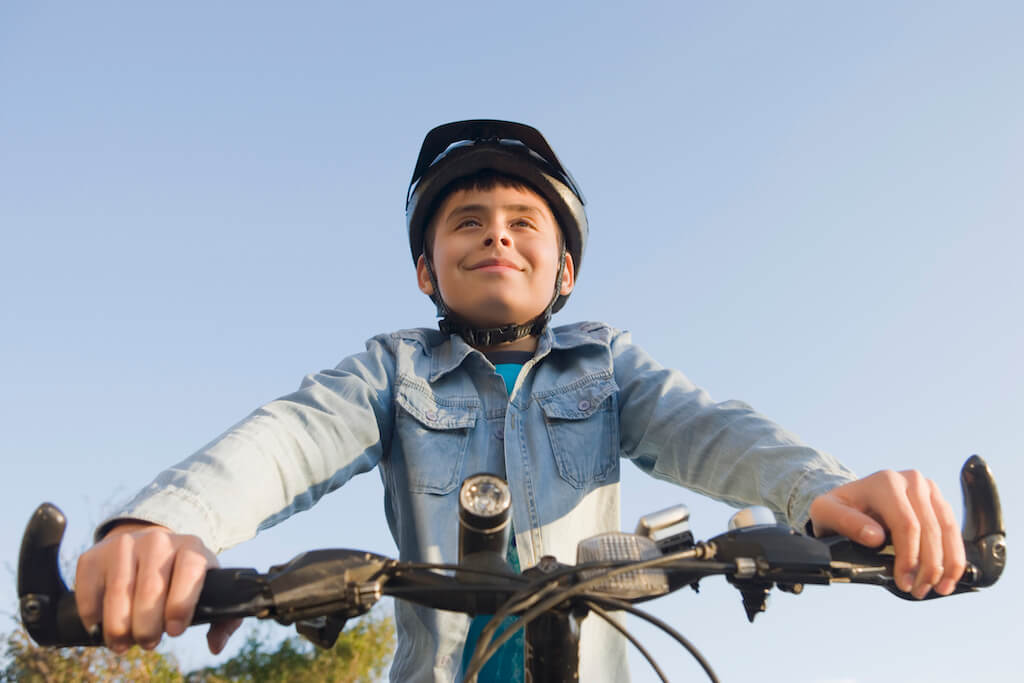Grade Level: Grades 7-8
Subject: Road Safety
Time Required: 60 minutes
Overall Expectations:
- Health and Physical Education 2019:
Grade 7 Active Living – B1, B3 - Health and Physical Education 2019:
Grade 8 Active Living – B1, B3 - Health and Physical Education 2019:
Grade 8 Movement, Skills and Concepts – C1 - Health and Physical Education 2019:
Grade 8 Healthy Living – D1
Introduction/Minds On
(10 - 15 minutes)
- STEP ONE: In class, students will use Appendix 5, Appendix 6, Appendix 7 and break into small groups to work on various problem solving scenarios related to Bicycle Helmet Safety. Instructions to activity are found in Appendix 5.
- STEP TWO: In class, to prepare for the activities in the gymnasium, students will use the visual organizer, Appendix 2, and discuss the ABC Quick Check for checking the working condition of a bicycle.
- STEP THREE: In class, using the visual organizer, Appendix 4, discuss with students the importance of hand signals when riding bicycles on streets and review how to do each signal with their left hand and when to do them.
Development/Action
(45 - 50 minutes)
- In the Gymnasium, Warm-up:
The teacher will review Appendix 2 – ABC Quick Check with students. These activities reinforce the ABC Quick Check that students need to do prior to riding a bike.
Teachers will call out A, B, C or Q and students will perform action.- A for Air (action: air squats),
- B for brakes (action: Low Plank Hold),
- C for Chain (action: mountain climb),
- Q for Quick Check (action: Burpee)
(Teachers can share instructional videos with students from Appendix 9 – Helpful Resources on each action prior to visiting gymnasium)
- Game – How to Play:
- Divide students into 2 different groups.
- Each group lines up at opposite ends of the gym.
- Each group gets one basketball, one hula hoop, and a bean bag for every student.
- Place your team’s hula hoop on the diagonal corner across from your team.
- One student from each group must move along the inner lines of the gymnasium towards their team’s hula hoop. They must keep the bean bag on top of their head while dribbling a ball in their right hand. Anytime they change direction on the lines, they must be using the proper bicycle hand signals.
- Once they have dropped their bean bag into their team’s hula hoop, they can travel along the outside lines back to their team. They will hand off the basketball to the next person in line.
- The object is to get everyone’s bean bag to the other end of the gymnasium before the other team.
- Students may walk or run with the bean bag on their head while bouncing a basketball in their right hand. (This represents balancing on a bicycle, while maintaining coordination to hold on to bicycle while signalling with left hand)
- HOWEVER, if a student has their bean bag fall off their head, or if they lose their basketball, they must stop, retrieve their item and do an ABC Q check on the spot. ABC Q involves doing 5 air squats (air), 5 second plank (brakes), 5 second Mountain climber (chain), 5 burpees (quick check).
- First team to have all their bean bags in the hula hoop and the opposite end of the gym wins.
- If a student is blocking another student doing the check, the blocked student can wait, or signal a change of direction and go on another line.
Extension: Grade 7/8 students can teach this game to primary students
Materials List
- Appendix 1 – (in-gymnasium) Game gymnasium set-up
- Appendix 2 – (in-gymnasium) Bike ABC Quick Check
- Appendix 3 – (in-gymnasium) Gymnasium ABC Quick Check motions
- Appendix 4 – (in-class) Bike Hand Signals
- Appendix 5 – (in-class) Helmet Safety (small group problem solving scenarios)
- Appendix 6 – (in class) Problem-Solving Map
- Appendix 7 – (in class) Helmet Problem Solving Scenario Cards
Additional Resources:
Required Equipment:
- Basketball
- Bean Bags
- Hula Hoops
Learning Outcomes
- Grade 7 & 8, Active Participation
- B1.1: actively participate according to their capabilities in a wide variety of program activities.
- Grade 7 & 8, Safety
- B3.1: demonstrate behaviours and apply procedures that maximize safety and lessen the risk of injury, including the risk of concussion, for themselves and others during physical activity.
- Grade 7 & 8, Stability
- C1.1: perform smooth transfers of weight and rotations, in relation to others and equipment, in a variety of situations involving static and dynamic balance.
- Grade 8, Personal Safety and Prevention
- D1.1: describe the signs and symptoms of concussions, as well as strategies that support healthy recovery.
